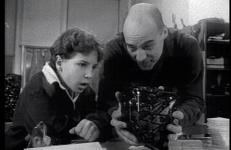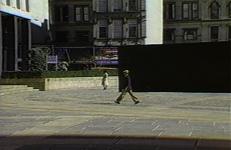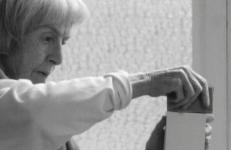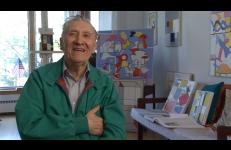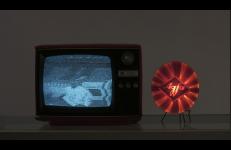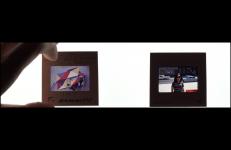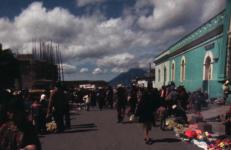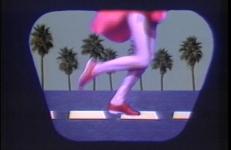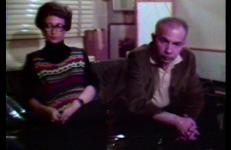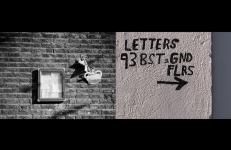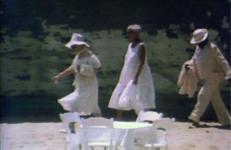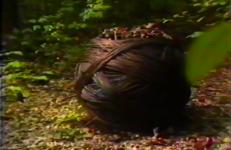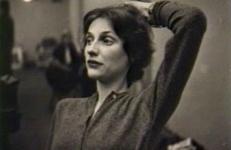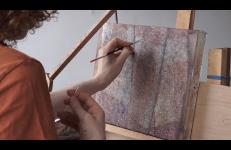Modeled after NBC’s long-running science program Watch Mr. Wizard, this tape features Torreano as Mr. Wizard instructing a skeptical boy on how to build a diamond out of pieces of wood. The boy remains unimpressed until Torreano uses a “video paintbox” to create flashy special effects. Painter John Torreano’s use of galaxy clusters as a reference for his fake jewel studded canvases and diamond-shaped sculptures suggested the nostalgic format of this video profile by MICA-TV.
Artist Portraits
The artwork on trial is Richard Serra's public sculpture, Tilted Arc, commissioned and installed by the U.S. government in 1981. Four years later, a public hearing was held to consider the removal of the sculpture from its site in Federal Plaza in New York City. In documenting the climatic General Services Administration hearing, The Trial Of Tilted Arc is a thought-provoking indictment of the state of the arts.
A short portrait of artist Anne Truitt (1921-2004). The film consists of an interview and 16mm footage made in and around her studio at the Yaddo artist colony, as well as footage from her home studio in Washington D.C. Rather than an attempt to depict her art, which is in many respects un-photographable, the core of the film is found in Truitt speaking about the course and meaning of her work. Says Cohen, "I was honored to know Anne Truitt, and doubly so when she allowed me to make a short record of her presence and thoughts.
tryphon: three sounds is a candid portrait of the artist Thomas H. Kapsalis (b.
Founded in 1997, the Arab Image Foundation preserves the legacy and collection of photographer Hashem el Madani and the Sheherazade photo studio.
This portrait is not simply an account of Simone Weil’s life, but rather the skein of her ideas. The “unoccupied zone” is therefore only marginally meant to refer to the southern part of France under Vichy. It is more importantly an existential labyrinth imaged by the film itself; a psychic space through which Weil passed while in exile in her own country.
This project started with an email from a stranger in 2017. The sender was the widower of the late artist Tania and he invited the filmmaker to look at her “archive.” Tania was born to Jewish parents in Poland in 1920. The family moved to Paris in the 1930s, but during the WWII they fed to Montreal, then emigrated to New York. Tania eventually became an artist. While facing many hurdles as a female artist in the 1960s and 70s, Tania vigorously created a wide range of artworks, not only paintings and three-dimensional pieces, but also public art projects.
A cross-generational binding of three filmmakers seeking alternative possibilities to the power structures they are inherently part of. Each woman extends her reach to a subject she is outside of. Vever grew out of the abandoned film projects of Maya Deren and Barbara Hammer. Shot at the furthest point of a motorcycle trip Hammer took to Guatemala in 1975, and laced through with Deren’s reflections of failure, encounter and initiation in 1950s Haiti.
A vever is a symbolic drawing used in Haitian Voodoo to invoke Loa, or god.
Part of the Long Beach Museum of Art’s Collectors of the Seventies series, this tape enters the home and art collection of Dorothy and Herbert Vogel. The Vogels live in a nondescript high-rise in the Yorkville section of New York City’s East Side. Their three and a half rooms serve as their museum for Larry Poons, Robert Morris, Philip Pearlstein, Robert Mangold, Sylvia Mangold, Dennis Oppenheim, Richard Nonas, John Tuttle, Sol Lewitt, Dan Graham, Richard Nonas, John Chamberlain, Christo, Donald Judd, Carl Andre, and Robert Ryman.
Interview by Douglas Davis.
A Walk with Nigel is a video essay that constructs a dialogue between two artists from two different times, between movement and stillness, between speech and silence. An archaeological study of a community, reawakening the archive in the present. A materialist study of streets and social relations.
In today’s youth-oriented society, the experience and knowledge of older women is typically unheralded and neglected. Countering these ideas is Suzanne Lacy’s Whisper, The Waves, The Wind—a performance evoking and reinforcing the strong spiritual and physical beauty of older women. Lacy says, “They reminded me of the place where the ocean meets shoreline. Their bodies were growing older, wrinkled. But what I saw was the rock in them; solid, with the presence of the years washing over them.” This tape is a document of that performance.
Director Jonathan Reiss and cinematographer/editor Leslie Asako Gladsjo traveled to Europe with Survival Research Laboratories to produce this entertaining and challenging portrait of the innovative group of artist technicians. The tape shows their machines in action and provides insight to their inspirations, political objectives, and budgetary constraints. The tape also reveals SRL’s efforts to confound and confront their foreign audiences with an artform that is, perhaps, uniquely American.
This is a three-part tape shot in 1975, ’76, and ’78 as Winsor was working on three pieces: 50/50, Copper Piece, and Burnt Piece. The rhythms and rituals of her working process as well as her comments on the work are documented. Part III is the only filmic record of the final stage of construction of Burnt Piece.
Woman as Protagonist: The Art of Nancy Spero is an invigorating look at the 40-year career of acclaimed feminist artist Nancy Spero, who, in her own works, is concerned with “rewriting the imaging of women through historical time.” With Spero’s own voice as narration, this documentary tracks her development as she matured against the grain of Abstract Expressionism, Minimalism, and Pop Art when “there wasn’t room in the art world to make way for political or activist art.” This tape includes footage of the artist at work on installations in the United States, Northern Ireland, and
Ellen Altfest is known for her representational paintings in which she renders every detail of her subjects on a one-to-one scale. The World Must Be Measured by Eye follows the meticulous, repetitive and painstaking creative process of Altfest—the painter studies the subject, mixes paint, matches colors, measures the distance and puts the paint on the canvas with a small brush. Through observing Altfest’s practice, The World Must Be Measured by Eye examines the act of creation and the act of seeing.
In this tape made shortly after fiber and sculpture artist Claire Zeisler’s death, art critic Dennis Adrian discusses her influence and aesthetic strategies. Adrian’s commentary is intercut with images of her work and archival footage of an interview with the artist.




